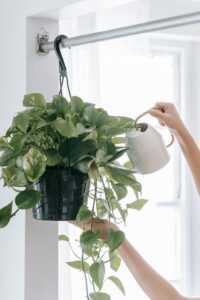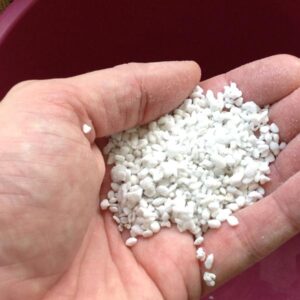Hanging plants are becoming increasingly popular in New Zealand, with options like hanging baskets and hanging planters offering a stylish way to bring greenery into homes and gardens. These planters make excellent use of vertical space, ideal for smaller areas where floor space is at a premium. Popular for their aesthetic appeal, ability to improve air quality, and vibrancy, hanging baskets and planters brighten up spaces indoors and outdoors, from balconies and patios to living rooms.
However, caring for plants in hanging baskets requires attention to detail, especially in terms of watering, lighting, and airflow. Here are essential tips for keeping your hanging plants thriving in New Zealand’s unique climate.
Choosing the Right Plants for Hanging Baskets and Planters in New Zealand
Best Types of Plants for Hanging Baskets
Selecting the right plants is key to successful hanging plant care. Some plants are better suited for hanging baskets due to their trailing growth habits or compact structures. Here are some ideal choices for New Zealand’s climate:
- Ferns: Ferns, such as the Boston and maidenhair fern, thrive in humid conditions and are perfect for shaded outdoor areas or moist indoor spots, making them popular for NZ hanging planters.
- Pothos: With lush green vines, pothos is a great indoor plant that tolerates low light and requires minimal maintenance. It cascades beautifully from hanging baskets.
- Spider Plants: Known for their air-purifying qualities, spider plants work well indoors and tolerate moderate light, making them a popular choice for hanging planters in New Zealand.
- Trailing Succulents (e.g., String of Pearls, Burro’s Tail): These unique succulents add a visual twist with their trailing forms. Thriving in bright, indirect light, they are ideal for outdoor hanging baskets in warmer regions.
Tips on Choosing Plants Based on Indoor vs. Outdoor Placement
Choosing plants to suit indoor or outdoor settings is essential. Indoor hanging baskets need plants that handle lower light levels, such as pothos and spider plants. Outdoor baskets exposed to direct sunlight are better suited to sun-tolerant plants like succulents and geraniums.
Considering Climate and Light Requirements
How New Zealand’s Climate Zones Impact Plant Selection
New Zealand’s climate ranges from subtropical in the north to cooler temperate zones in the south. In subtropical areas like Northland, moisture-loving plants like ferns do well outdoors. In cooler regions, hardy succulents or cold-resistant plants are more suitable for outdoor hanging planters.
Guide to Choosing Plants for Different Light Conditions
- Low-Light Plants: Ideal for indoor hanging baskets placed away from direct sunlight (e.g., ferns, pothos).
- Bright Indirect Light: Perfect for spaces near windows or shaded patios, offering sufficient light without direct sun exposure (e.g., spider plants, philodendrons).
- Full Sun: Some hanging plants thrive in direct sunlight outdoors, including geraniums and trailing succulents.
Essential Watering Tips for Hanging Baskets and Planters
How Often to Water Hanging Baskets
Hanging baskets dry out more quickly than ground pots due to increased airflow. During warmer months, many hanging plants need watering every 1-2 days. In cooler months, watering needs may decrease. Plant type, pot material, and location also affect watering frequency. Plants like ferns need consistently moist soil, while succulents prefer the soil to dry out between waterings.
Watering Techniques for Hanging Baskets

- Bottom-Watering: Place the basket in a shallow tray of water to allow moisture absorption through drainage holes.
- Drip Trays: For indoor hanging planters, use drip trays to catch excess water and prevent spills.
- Long-Spout Watering Can: For high-up baskets, use a watering can with a long spout to reach the soil without taking down the pot.
Preventing Overwatering and Underwatering
- Signs of Overwatering: Yellow leaves, mouldy soil, and a musty smell often indicate overwatering.
- Signs of Underwatering: Wilting leaves, dry soil, and stunted growth are signs of underwatering.
Proper drainage is crucial to prevent root rot, so choose pots with drainage holes and consider adding a layer of pebbles to improve water flow.
Managing Light and Temperature for Hanging Planters
Finding the Right Spot for Indoor and Outdoor Hanging Planters
- Indoors: Place hanging baskets near windows for indirect light or under skylights for moderate light. Avoid direct sunlight unless the plants are sun-tolerant.
- Outdoors: Position hanging planters on patios or verandas where they receive morning sunlight but are shaded during the afternoon. Adjust placements seasonally to match changing light patterns.
Protecting Hang
ing Baskets from Temperature Extremes
New Zealand’s seasonal shifts affect hanging plants, especially in peak summer and winter. During hot summers, move baskets to shaded areas or use shade cloth for sensitive plants. In cold winters, bring plants indoors or use frost protection to guard against low temperatures.
Soil, Fertilising, and Potting Mix Tips for Hanging Planters
Choosing the Right Soil Mix for Hanging Baskets
The soil mix used impacts plant health significantly:
- Succulents and Cacti: Use well-draining cactus soil to prevent root rot in outdoor baskets.
- Ferns and Moisture-Loving Plants: Select a peat-based potting mix to retain moisture for ferns.
- Flowering Plants: A general-purpose potting mix with good drainage works for most flowering plants in hanging baskets.
Fertilising Tips for Hanging Planters
Regular fertilising keeps hanging plants healthy:

- Indoor Plants: Feed every 6-8 weeks with a balanced liquid fertiliser.
- Outdoor Plants: Use a slow-release fertiliser at the beginning of each growing season for long-lasting blooms and healthy foliage.
Adjust fertilising frequency during the active growing season (spring and summer) and reduce it in cooler months.
Pruning, Rotating, and Maintenance Tips
Pruning Hanging Baskets for Optimal Growth
Pruning maintains fullness and prevents legginess. Remove yellowing leaves or spent flowers to encourage new growth and keep plants tidy.
Rotating Hanging Planters for Even Growth
Rotate planters every two weeks to promote balanced growth toward light sources, preventing a lopsided appearance.
Routine Maintenance: Cleaning and Checking for Pests
Regular dusting of leaves and pest checks are essential. Dusty leaves hinder photosynthesis; gently wipe them with a damp cloth. Look out for pests like spider mites and aphids, treating any infestations promptly with neem oil or insecticidal soap.
Tips for Hanging Pot Placement and Mounting Options
Choosing Hanging Hardware and Hooks for Stability
Select strong, durable hooks for hanging baskets, especially for heavy ceramic or large planters. Check weight limits to keep plants secure.
Creative Ideas for Displaying Hanging Planters in Small Spaces
Make the most of limited space by arranging hanging plants creatively:
- Wall Mounts: Mount smaller pots on walls to save floor space.
- Ceiling Hooks: Use ceiling hooks to create a layered, vertical garden.
- Multi-Pot Hangers: Tiered baskets display multiple plants without occupying floor or counter space.
Seasonal Care Tips for Hanging Baskets in New Zealand
Adapting Care Routines for Different Seasons
New Zealand’s seasons require care adjustments:
- Spring/Summer: Increase watering frequency and fertilise every 6-8 weeks.
- Autumn/Winter: Reduce watering, especially for succulents, and ensure indoor plants receive adequate light.
Moving Hanging Planters Indoors and Outdoors with the Seasons
Move delicate plants indoors during winter to protect them from frost. In spring, gradually transition them back outdoors, starting with shaded areas and slowly increasing light exposure to avoid shock.
Caring for hanging baskets and planters in New Zealand involves balancing watering, light, temperature, and soil requirements. By choosing suitable plants, adjusting routines seasonally, and experimenting with different care techniques, you can enjoy the vibrant beauty hanging plants bring to your NZ home or garden.


